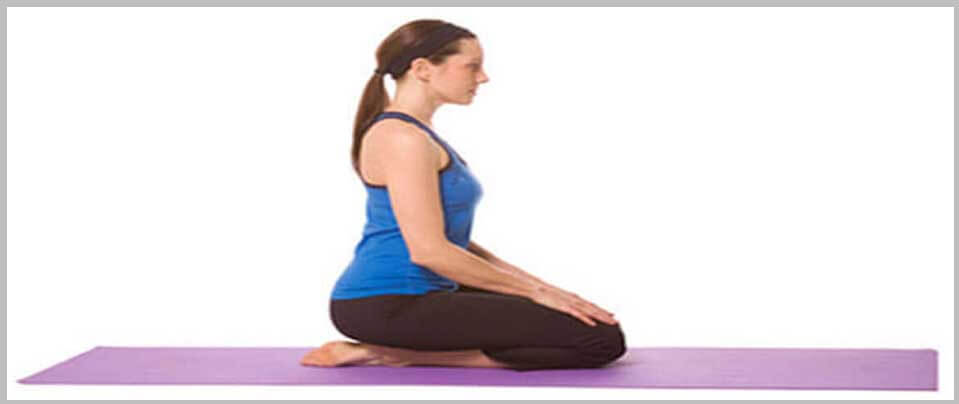
Vajrasan for Weight Loss
Vajrasana is the magical yoga asana that helps us melt the belly fat. If you are slim and trim with flat belly, you would definitely want to maintain this figure. Practice Vajrasana regularly for at least 15-20 minutes immediately after meals and you won’t later regret. Vajrasana comes from two words Vajra and asana; Vajra meaning diamond and asana meaning pose. Those who sit in this Asana have a steady, firm pose.
How to do Vajrasana?
1. Kneel down with lower legs stretched straight backwards and toes crossing each other.
2. Sit over the heels – your buttocks should sit on the heels and thighs on the calf muscles.
3. Sit straight with head facing forward and hands on your knees.
4. Close your eyes (optional) and focus on breath observing inhalation and exhalation.
5. Practice this position for 5 – 10 minutes in initial days and increase gradually up to 20 – 30 minutes.
Vajrasana - Points to Remember
1. You may feel pain in the legs when you begin to practice this asana. If your leg aches, undo the asana and stretch your legs. Now massage your ankles, knees and calf muscles with hand. This soothes the muscles and pain gradually fades.
2. If you have knee problem, have history of knee injury or had recent knee surgery; don’t practice Vajrasana.
3. You can still practice this asana if you are pregnant. Be cautious to keep your knees apart to not stress your abdomen.
Benefits of Vajrasana
1. Vajrasana helps better blood circulation in the body. It modifies the blood flow by reducing the blood flow in lower portion, especially in the legs and increasing blood flow to the digestive organs resulting to efficiency of the digestive system. People with weak digestion are benefited. Better digestion checks acidity and ulcers.
2. People with sciatica and severe lower back problems should regularly practice vajrasana to be benefited.
3. Vajrasana is the answer to constipation, stomach disorder, digestive problems, acidity. It makes lower body flexible, strengthens sexual organs, tones body muscles (hips, thighs, calves), cures joint pains, urinary problems, etc.
4. Losing weight becomes possible with regular practice of Vajrasana. You will see the difference in your belly fat after a few weeks of regular Vajrasana practice.
5. Vajrasana calms mind and relaxes the nerves.
6. Slow and rhythmic breathing in this position can induce a meditative state.
Variations
Kurmasana (Tortoise Pose): After sitting on Vajrasana, firmly press the buttocks with the soles. Your head, neck and trunk are already erect, you can keep your hands on hips, knees or on the sides of the chest. Remain in this position for 3 minutes to as long as you can.
Ardha Kurmasana: While sitting in Vajrasana, stretch your both hands straight to your face level; the palms should face each other. Slowly bend and lie down on the ground on the support of your hands. Remain in this position for as long as you are comfortable.
Utthana Kurmasana: Release your buttocks from the seated position over the ankles. Put the ankles so close that they are one over the other; your spine, neck and head erect. Keep your hands in between calves and thighs. Now slowly release the hands and press the head with your hands looking downward. Sprains and pains in the back will disappear.
Mandukasana (Frog Pose): In Vajrasana, relax your knees keeping them at the sides. Keep your hands on the knees. Stay in this position for as long as you can.
Padadirasana: Sitting on Vajrasana, stretch your hands to the chest level, palms facing each other.
Parvatasana: Gradually raise your body and the hands above from your original Vajrasana position.
Ananda Mandirasana: Release your hands from the knees in your Vajrasana and hold the heels with your two hands.
Angushthasana: From your Vajrasana, slowly raise the knees trying to maintain position in the toes alone.
Supta Vajrasana: From your Vajrasana, release hands from the knees. Gradually bend backwards. Place your forearm and elbows on the floor and arch the spine and neck back until the crown of the head touches the ground. Take normal breaths. Remain in this position for as long as you are comfortable. Don’t try this asana until you have gained command over Vajrasana. Beware, your knees are in more pressure in this position than in Vajrasana.